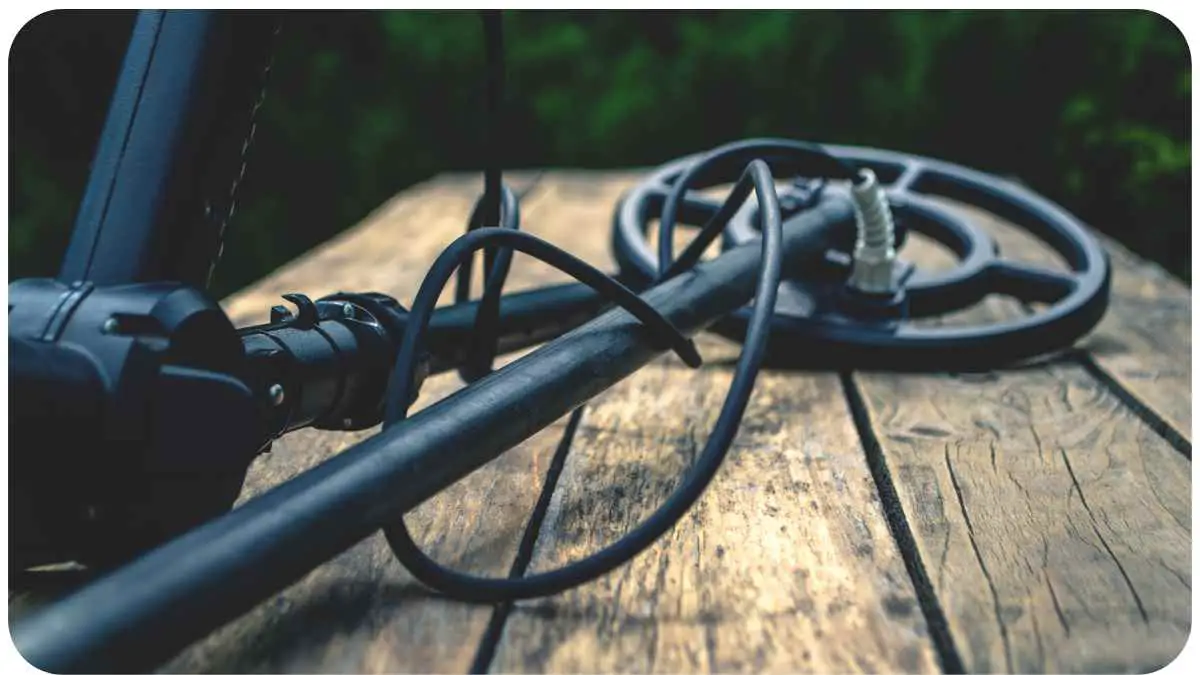Welcome to our comprehensive guide on fixing false signals on your metal detector. There’s nothing more frustrating than being misled by signals that turn out to be false positives. These false signals not only waste precious time but also undermine the excitement of a potential great find.
In this article, we will explore the causes of false signals, troubleshooting techniques, and effective solutions to ensure accurate detection and improve your metal detecting experience.
| Takeaways |
|---|
| Your Guide to Troubleshooting Your Metal Detector |
| – Learn troubleshooting techniques for metal detectors |
| – Understand common issues and their solutions |
| – Improve your detecting experience with troubleshooting tips |
| – Gain insights into target identification and discrimination |
| – Navigate challenges and minimize false signals effectively |
2. Understanding False Signals on Metal Detectors
2.1 What Causes False Signals?
False signals can be triggered by various factors, including mineralization and ground conditions, electrical interference, trash and debris, improper coil usage, and sensitivity settings. Each of these factors can lead to misleading signals, making it essential to identify and address them properly.
Encountering issues with your Garrett AT Max? Fret not! Dive into our guide on Troubleshooting Tips for Your Garrett AT Max Metal Detector and transform your detecting experience. Every tool has its quirks; understanding them is the key!
2.2 Differentiating False Signals from Genuine Finds
It’s important to develop the skill of distinguishing between false signals and genuine finds. Look for patterns and consistency in the signals, consider the location, and pay attention to the overall context to minimize the chances of mistaking a false signal for a valuable discovery.
2.3 The Impact of False Signals on Your Metal Detecting Experience
False signals not only waste time and energy but also dampen the thrill of metal detecting. They can discourage beginners and even frustrate experienced detectorists. By understanding and resolving false signals, you can enhance the accuracy of your metal detector and enjoy a more productive and satisfying metal detecting adventure.
Table 2.3: Effects of False Signals
| Effects of False Signals |
| Time wasted on digging up potential non-existent finds |
| Decreased enthusiasm and enjoyment |
| Misjudgment of target consistency and depth |
| Inaccurate identification of valuable targets as junk |
| Unnecessary strain on your body from digging up false targets |
| Missed opportunities for genuine discoveries |
| Diminished confidence in your metal detector |
Table 2.3 provides an overview of the effects of false signals on your metal detecting experience.
3. Identifying Common False Signal Causes

To effectively address false signals, it’s crucial to identify their common causes. By understanding these causes, you can implement targeted solutions and minimize the occurrence of false positives.
3.1 Mineralization and Ground Conditions
Mineral-rich soil and highly mineralized areas can generate false signals on your metal detector. Conduct research about the ground conditions of your detecting site to better understand its mineral content. Adjusting your detector’s settings to account for mineralization can greatly reduce false signals.
For enthusiasts utilizing the Minelab Equinox 800, occasional challenges may arise. However, with our comprehensive post on How to Fix Common Problems with Your Minelab Equinox 800, you’ll be more than equipped to address and resolve them swiftly.
3.2 Electrical Interference
Electrical interference, such as power lines, radio waves, or nearby electronic devices, can interfere with your metal detector’s signals and cause false readings. Reduce the impact by adjusting the sensitivity settings and using noise-canceling headphones.
3.3 Trash or Debris
An abundance of trash or metal debris in an area can lead to false signals. Familiarize yourself with the surroundings and the likelihood of encountering junk, such as soda cans or nails. Adjust your discrimination settings to ignore common trash items while still detecting valuable targets.
3.4 Improper Coil Usage
Using the wrong coil size or incorrect coil control techniques may contribute to false signals. Ensure that your coil is appropriate for the detecting conditions and handle it properly, maintaining a consistent and steady swing motion.
Getting acquainted with the nuances of a new metal detector can be challenging. That’s why we’ve crafted a beginner’s guide specifically for the Understanding Your Whites MX7 Metal Detector. Delve into it and bring clarity to your treasure hunting journey!
Table 3.4: Common Coil Usage Issues
| Common Coil Usage Issues | Effects |
| Using an excessively large or small coil | Inaccurate depth perception and inconsistent signals |
| Incorrect swing motion technique | Unstable signals and missed target identification |
| Mishandling the coil (e.g., hitting the ground) | Noisy and erratic signals, leading to false positives |
Table 3.4 highlights some common issues related to coil usage that can result in false signals.
3.5 Sensitivity Settings
Incorrect sensitivity settings can cause your metal detector to overreact to signals, resulting in false positives. Experiment with sensitivity levels to find the optimal setting for your specific detecting site and conditions.
4. Effective Techniques for Minimizing False Signals
Now that you are familiar with the common causes of false signals, let’s explore some effective techniques to minimize them. These techniques will help you achieve more accurate target identification, leading to a more successful and enjoyable metal detecting experience.
4.1 Ground Balancing
Ground balancing is a crucial step in reducing false signals caused by mineralization. This process adjusts your detector to account for the mineral content in the soil. Consult your metal detector’s manual to learn how to ground balance properly, as each model may have specific instructions.
4.2 Discrimination and Notching
Discrimination and notching features allow you to differentiate between various target types and exclude undesirable signals, such as iron or aluminum. Experiment with discrimination settings to find a balance between filtering out unwanted targets and still detecting valuable finds.
Table 4.2: Discrimination and Notching Settings
| Metal Discrimination Settings | Effects |
| High discrimination (excluding iron and low-value metals) | Reduces false signals, but risks missing valuable targets |
| Partial discrimination (excluding specific target types) | Increases chances of detecting valuable finds, with some false signals |
| Low discrimination (including all metals) | Minimizes missed targets, but increases likelihood of false signals |
Table 4.2 showcases different discrimination settings and their impact on false signals and target identification.
4.3 Proper Coil Control and Swing Techniques
Maintaining proper coil control and swing techniques is essential to reduce false signals. Keep the coil parallel to the ground, maintaining a consistent height and distance. Avoid rapid or erratic swinging, as it may result in false readings.
Even with the most reliable tools, glitches and errors can emerge. It’s essential to have a handy resource like our How to Fix a Faulty Metal Detector: Troubleshooting Tips article to guide you through those trying moments, ensuring you’re back on track in no time.
4.4 Modifying Sensitivity Settings
Experimenting with sensitivity settings can help minimize false signals caused by electrical interference or highly mineralized soil. Adjust the sensitivity levels incrementally and listen to the changes in the signals. Find the setting that allows for accurate target detection while minimizing false positives.
5. Advanced Solutions and Troubleshooting Techniques
In some cases, standard techniques may not be sufficient to eliminate persistent false signals. Let’s explore some advanced solutions and troubleshooting techniques that can help you tackle challenging situations and minimize false readings.
5.1 Using Iron Audio and Notch Discrimination
Metal detectors equipped with iron audio and notch discrimination features allow you to audibly identify and ignore iron signals. By utilizing these features, you can differentiate iron targets from potentially valuable finds and reduce false signals caused by iron-rich areas.
5.2 Adjusting Recovery Speed and Threshold Levels
Adjusting the recovery speed and threshold levels on your metal detector can help you fine-tune the detection settings. Slower recovery speeds can improve target separation, reducing the chances of false signals. Additionally, adjusting the threshold level can help establish a stable baseline and enhance signal clarity.
There’s nothing more frustrating than an incessantly beeping detector without clear reason. To alleviate this, we’ve outlined a simple solution in our article: What Happens When Your Metal Detector Keeps Beeping? Here’s an Easy Fix!. Dive in, and eliminate that annoyance swiftly!
5.3 Employing Frequency Shifts
Frequency shifts can be useful in minimizing interference from other metal detectors or electrical devices in the area. Experiment with different frequencies to find the one that offers the most stable and accurate signal readings.
Table 5.3: Frequency Shift Examples
| Frequency Shift | Effects |
| Increase in frequency | Reduces interference from low-frequency devices, such as power lines |
| Decrease in frequency | Minimizes interference from high-frequency devices, such as radios |
Table 5.3 provides examples of frequency shifts and their effects on interference reduction.
5.4 Ground Filtering Techniques
Some advanced metal detectors come with ground filtering options that allow you to fine-tune the settings in heavily mineralized soil. Explore the ground filtering options available on your detector and adjust them to suppress false signals caused by mineralization.
5.5 Firmware Updates and Maintenance
Regularly check for firmware updates from the manufacturer of your metal detector. These updates can provide bug fixes, improvements, and performance enhancements that may help reduce false signals. Additionally, proper maintenance of your detector, such as keeping it clean and ensuring all connections are secure, can minimize false readings.
6. Cases of Persistent False Signals and Complex Solutions

While standard techniques and advanced solutions can effectively handle most false signals, certain situations may require more complex solutions. Let’s explore some cases of persistent false signals and discuss the corresponding advanced techniques to address them.
6.1 Deep Iron and Hot Rocks
In areas with deep iron deposits or hot rocks, false signals can be a persistent issue. One approach to mitigate false signals in these scenarios is to utilize pulse induction (PI) metal detectors. PI detectors are less affected by the presence of iron and hot rocks, allowing for more accurate target detection in challenging environments.
6.2 Saltwater and Wet Sand
When detecting on saltwater beaches or in wet sand, false signals can be frequent due to the high mineral content and conductivity. Using a waterproof metal detector specifically designed for saltwater and wet sand detecting can help minimize false readings in these conditions.
Additionally, adjusting the sensitivity and ground balance settings specifically for saltwater environments is crucial.
6.3 Congested Areas with High Electrical Activity
In highly congested areas with high levels of electrical activity, such as parks or sports fields, false signals from electrical interference can be a major challenge.
Deploying a metal detector with advanced noise-canceling features and highly adjustable settings can help mitigate false signals. Additionally, using smaller coil sizes and discriminating against common trash items can assist in filtering out unwanted signals.
6.4 Intermittent or Random False Signals
Intermittent or random false signals can be frustrating as they disrupt the detecting process without a clear cause. In such cases, reviewing your detecting technique, such as swing motion or coil control, is crucial. Additionally, re-ground balancing and re-checking the discrimination settings can help ensure accurate target identification and minimize false signals.
7. Expert Tips and Best Practices
To further enhance your metal detecting experience and minimize false signals, consider implementing the following expert tips and best practices:
7.1 Conducting Site Surveys and Research
Before heading out to detect, conduct site surveys and research to gather information about the history of the location. Understanding the potential presence of valuable targets or sources of false signals can better prepare you for accurate target identification.
7.2 Keeping a Logbook and Recording Findings
Maintaining a logbook to record your findings, including the type of signals encountered and their outcomes, can help identify patterns and improve your ability to distinguish false signals from genuine finds. Over time, this logbook can become a valuable resource for future detecting sessions.
7.3 Including Visual Aids and Benchmarks
Taking photos or making sketches of the target signals and surrounding area can provide visual references for future comparisons. These visual aids can help you better understand the signals encountered and make more informed decisions about target identification.
7.4 Collaborating with Local Detectorists and Experts
Engaging with local detectorists and experts can provide valuable insights and advice specific to your detecting area. Sharing experiences and knowledge with others in the metal detecting community can enhance your understanding of false signals and lead to more successful detecting sessions.
7.5 Staying Persistent and Patient
Addressing false signals requires patience and persistence. It takes time and practice to become proficient at distinguishing between false signals and genuine finds. Remember to stay positive, learn from each detecting experience, and celebrate both the successes and challenges along the way.
8. Conclusion
False signals are an inevitable part of metal detecting, but armed with the knowledge and techniques outlined in this comprehensive guide, you can minimize their impact on your detecting experience.
By understanding the common causes of false signals, implementing effective techniques to reduce them, and utilizing advanced solutions in more challenging situations, you can improve the accuracy of your metal detector and increase the likelihood of finding valuable treasures. Remember to remain patient, persistent, and open to learning from each detecting session. Happy hunting!
Further Reading
Your Guide to Troubleshooting Your Metal Detector: This resource provides in-depth information on troubleshooting techniques for metal detectors, covering common issues and their solutions.
Diggers and Detectors: Explore this website for a wide range of articles, guides, and resources related to metal detecting. It offers information on detecting techniques, equipment reviews, and troubleshooting tips.
Metal Detector Troubleshooting: This informative resource focuses on troubleshooting techniques specifically tailored for metal detectors. It covers various topics including target identification, discrimination, and handling false signals.
FAQs
How can I differentiate false signals from genuine finds?
Differentiating false signals from genuine finds requires experience and attention to details. Look for consistency in the signals, consider the location’s history, and pay attention to the overall context of the find.
How can I reduce false signals caused by highly mineralized soil?
To reduce false signals from mineralized soil, ground balancing is essential. Consult your metal detector’s manual to learn the specific process for your detector model.
What can I do to minimize false signals caused by electrical interference?
To minimize false signals from electrical interference, try adjusting the sensitivity settings and using noise-canceling headphones. Additionally, selecting a different frequency or employing frequency shifts can also help reduce interference.
How can I handle false signals caused by trash or debris?
You can address false signals caused by trash or debris by adjusting the discrimination settings on your metal detector. Experiment with different discrimination levels to filter out common undesirable targets such as iron or aluminum.
Are there any advanced techniques for dealing with persistent false signals?
Yes, for persistent false signals, advanced techniques like using iron audio and notch discrimination, adjusting recovery speed, employing ground filtering, and utilizing pulse induction detectors in certain scenarios can be effective solutions.
How important is proper coil control and swing technique?
Proper coil control and swing technique are crucial to minimize false signals. Maintaining a consistent height and distance from the ground, and swinging the coil parallel to the surface can improve target identification and reduce false positives.

Hi there! My name is Hellen James, and I’m here to talk to you about treasure hunting. I’ve been a fan of treasure hunting ever since I was a kid, and if you’re a fan of treasure hunting or just like the idea of finding a long-lost fortune, then this blog is for you.

